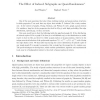Free Online Productivity Tools
i2Speak
i2Symbol
i2OCR
iTex2Img
iWeb2Print
iWeb2Shot
i2Type
iPdf2Split
iPdf2Merge
i2Bopomofo
i2Arabic
i2Style
i2Image
i2PDF
iLatex2Rtf
Sci2ools
SODA
2008
ACM
2008
ACM
The effect of induced subgraphs on quasi-randomness
One of the main questions that arise when studying random and quasi-random structures is which properties P are such that any object that satisfies P "behaves" like a truly random one. In the context of graphs, Chung, Graham, and Wilson [8] call a graph p-quasi-random if it satisfies a long list of the properties that hold in G(n, p) with high probability, like edge distribution, spectral gap, cut size, and more. Our main result here is that the following holds for any fixed graph H: if the distribution of induced copies of H in a graph G is close (in a well defined way) to the distribution we would expect to have in G(n, p), then G is either p-quasi-random or p-quasi-random, where p is the unique non-trivial solution of the polynomial equation x (1-x)1= p (1-p)1, with being the edge density of H. We thus infer that having the correct distribution of induced copies of any single graph H is enough to guarantee that a graph has the properties of a random one. The proof techni...
| Added | 30 Oct 2010 |
| Updated | 30 Oct 2010 |
| Type | Conference |
| Year | 2008 |
| Where | SODA |
| Authors | Asaf Shapira, Raphael Yuster |
Comments (0)

